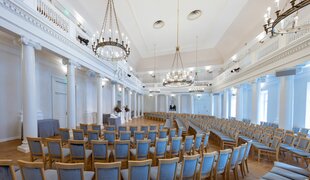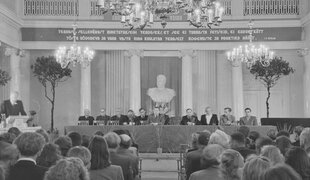-
Faculty of Arts and HumanitiesDean's Office, Faculty of Arts and HumanitiesJakobi 2, r 116-121 51005 Tartu linn, Tartu linn, Tartumaa EST0Institute of History and ArchaeologyJakobi 2 51005 Tartu linn, Tartu linn, Tartumaa EST0Institute of Estonian and General LinguisticsJakobi 2, IV korrus 51005 Tartu linn, Tartu linn, Tartumaa EST0Institute of Philosophy and SemioticsJakobi 2, III korrus, ruumid 302-337 51005 Tartu linn, Tartu linn, Tartumaa EST0Institute of Cultural ResearchÜlikooli 16 51003 Tartu linn, Tartu linn, Tartumaa EST0Institute of Foreign Languages and CulturesLossi 3 51003 Tartu linn, Tartu linn, Tartumaa EST0School of Theology and Religious StudiesÜlikooli 18 50090 Tartu linn, Tartu linn, Tartumaa EST0Viljandi Culture AcademyPosti 1 71004 Viljandi linn, Viljandimaa EST0Professors emeriti, Faculty of Arts and Humanities0Associate Professors emeriti, Faculty of Arts and Humanities0Faculty of Social SciencesDean's Office, Faculty of Social SciencesLossi 36 51003 Tartu linn, Tartu linn, Tartumaa EST0Institute of EducationJakobi 5 51005 Tartu linn, Tartu linn, Tartumaa EST0Johan Skytte Institute of Political StudiesLossi 36, ruum 301 51003 Tartu linn, Tartu linn, Tartumaa EST0School of Economics and Business AdministrationNarva mnt 18 51009 Tartu linn, Tartu linn, Tartumaa EST0Institute of PsychologyNäituse 2 50409 Tartu linn, Tartu linn, Tartumaa EST0School of LawNäituse 20 - 324 50409 Tartu linn, Tartu linn, Tartumaa EST0Institute of Social StudiesLossi 36 51003 Tartu linn, Tartu linn, Tartumaa EST0Narva CollegeRaekoja plats 2 20307 Narva linn, Ida-Virumaa EST0Pärnu CollegeRingi 35 80012 Pärnu linn, Pärnu linn, Pärnumaa EST0Professors emeriti, Faculty of Social Sciences0Associate Professors emeriti, Faculty of Social Sciences0Faculty of MedicineDean's Office, Faculty of MedicineRavila 19 50411 Tartu linn, Tartu linn, Tartumaa ESTInstitute of Biomedicine and Translational MedicineBiomeedikum, Ravila 19 50411 Tartu linn, Tartu linn, Tartumaa ESTInstitute of PharmacyNooruse 1 50411 Tartu linn, Tartu linn, Tartumaa ESTInstitute of DentistryL. Puusepa 1a 50406 Tartu linn, Tartu linn, Tartumaa ESTInstitute of Clinical MedicineL. Puusepa 8 50406 Tartu linn, Tartu linn, Tartumaa ESTInstitute of Family Medicine and Public HealthRavila 19 50411 Tartu linn, Tartu linn, Tartumaa ESTInstitute of Sport Sciences and PhysiotherapyUjula 4 51008 Tartu linn, Tartu linn, Tartumaa ESTProfessors emeriti, Faculty of Medicine0Associate Professors emeriti, Faculty of Medicine0Faculty of Science and TechnologyDean's Office, Faculty of Science and TechnologyVanemuise 46 - 208 51003 Tartu linn, Tartu linn, Tartumaa ESTInstitute of Computer ScienceNarva mnt 18 51009 Tartu linn, Tartu linn, Tartumaa ESTInstitute of GenomicsRiia 23b/2 51010 Tartu linn, Tartu linn, Tartumaa ESTEstonian Marine Institute0Institute of PhysicsInstitute of ChemistryRavila 14a 50411 Tartu linn, Tartu linn, Tartumaa EST0Institute of Mathematics and StatisticsNarva mnt 18 51009 Tartu linn, Tartu linn, Tartumaa EST0Institute of Molecular and Cell BiologyRiia 23, 23b - 134 51010 Tartu linn, Tartu linn, Tartumaa ESTTartu ObservatoryObservatooriumi 1 61602 Tõravere alevik, Nõo vald, Tartumaa EST0Institute of TechnologyNooruse 1 50411 Tartu linn, Tartu linn, Tartumaa ESTInstitute of Ecology and Earth SciencesJ. Liivi tn 2 50409 Tartu linn, Tartu linn, Tartumaa ESTProfessors emeriti, Faculty of Science and Technology0Associate Professors emeriti, Faculty of Science and Technology0Institute of BioengineeringArea of Academic SecretaryHuman Resources OfficeUppsala 6, Lossi 36 51003 Tartu linn, Tartu linn, Tartumaa EST0Area of Head of FinanceFinance Office0Area of Director of AdministrationInformation Technology Office0Administrative OfficeÜlikooli 17 (III korrus) 51005 Tartu linn, Tartu linn, Tartumaa EST0Estates Office0Marketing and Communication OfficeÜlikooli 18, ruumid 102, 104, 209, 210 50090 Tartu linn, Tartu linn, Tartumaa EST0Area of Vice Rector for ResearchUniversity of Tartu LibraryW. Struve 1 50091 Tartu linn, Tartu linn, Tartumaa EST0Grant OfficeArea of Vice Rector for DevelopmentCentre for Entrepreneurship and InnovationNarva mnt 18 51009 Tartu linn, Tartu linn, Tartumaa EST0University of Tartu Natural History Museum and Botanical GardenVanemuise 46 51003 Tartu linn, Tartu linn, Tartumaa EST0International Cooperation and Protocol Office0University of Tartu MuseumLossi 25 51003 Tartu linn, Tartu linn, Tartumaa EST0Area of RectorRector's Strategy OfficeInternal Audit OfficeArea of Vice Rector for Academic AffairsOffice of Academic AffairsUniversity of Tartu Youth AcademyUppsala 10 51003 Tartu linn, Tartu linn, Tartumaa EST0Student Union OfficeÜlikooli 18b 51005 Tartu linn, Tartu linn, Tartumaa EST0Centre for Learning and Teaching
Exhibition “Signs of Power”
The exhibition “Signs of Power”, opening at the University of Tartu Art Museum on 1 February, focuses on the University of Tartu Assembly Hall and examines the changes in this space under the influence of different powers. An installation created by group of young artists Ajuokse (Brain Vomit) lends a future perspective to the exhibition.
The University of Tartu Assembly Hall, this strictly classicist and solemnly academic white pillared hall, may seem completely neutral at first glance. However, digging into the hall's more than two hundred years of history reveals how all the powers that ruled Estonia in the 19th and 20th centuries wanted to establish themselves there visually and monumentally.
"The exhibition guides the visitor to see the hall as a space from a new perspective and to search for answers as to why each state power has wanted to shape it in its own image. More broadly, we are looking for an answer to the question of how free we are in deciding what is right and beautiful, and to what extent our opinions are influenced."
Power in society does not only manifest itself through laws, orders and prohibitions. Often, it takes place in more covert ways and expresses itself also in the space around us. Our physical environment reflects our cultural and socio-political choices and the ideological views and preferences of the ruling social groups.
The university assembly hall is a notable example of a remarkable public space that was deliberately decorated with the desire to perpetuate the ruling ideology and in which elements and understandings of different eras have been gradually passed on or replaced. Be it works of art, ideological symbols, furnishings or the layout of the space.
We examine the ways in which the ruling powers’ values and attitudes have been presented in the hall during four political eras. We ask what means have been used to emphasise the political importance of the hall, how the signs have changed over time and how we perceive them today.
The exhibition is not limited to looking at the past. Artists from the Ajuokse group bring an alternative set of symbols to the exhibition hall with an installation that dreams of a more conscious society. After the exhibition presents us with choices made in the past, the installation raises the question of what kind of space and society we want to create around us today. What are the signs of power surrounding us that we may not notice, and how can we recognise them in the future?
Curator: Ken Ird
Designer: Stina Leek
Graphic Design: Ingmar Järve
Installation: Ajuokse rühmitus (Stina Leek, Paul Lepasson, Sander Raudsepp, Ulrike Brett Uukkivi, Ann Tuksam)
Exhibition Team: Karoliina Kalda, Maria Kullamägi
Marketing and Communication: Ilona Piirimägi
Print: Salibar OÜ
Consultants: Tiit Remm ja Andreas Ventsel (Tartu Ülikooli filosoofia ja semiootika instituut)
Materials: Rahvusarhiiv, Tartu Ülikool, Eesti Rahva Muuseum, Tartu Ülikooli muuseum, Tartu Ülikooli raamatukogu, Indrek Ilometsa erakogu
Thank you: Indrek Ilomets, Kristi Kallion, Kaidi Marii Kütt, Nele Novek (Tartu Ülikooli Akadeemiline Naiskoor), Andres Tennus




